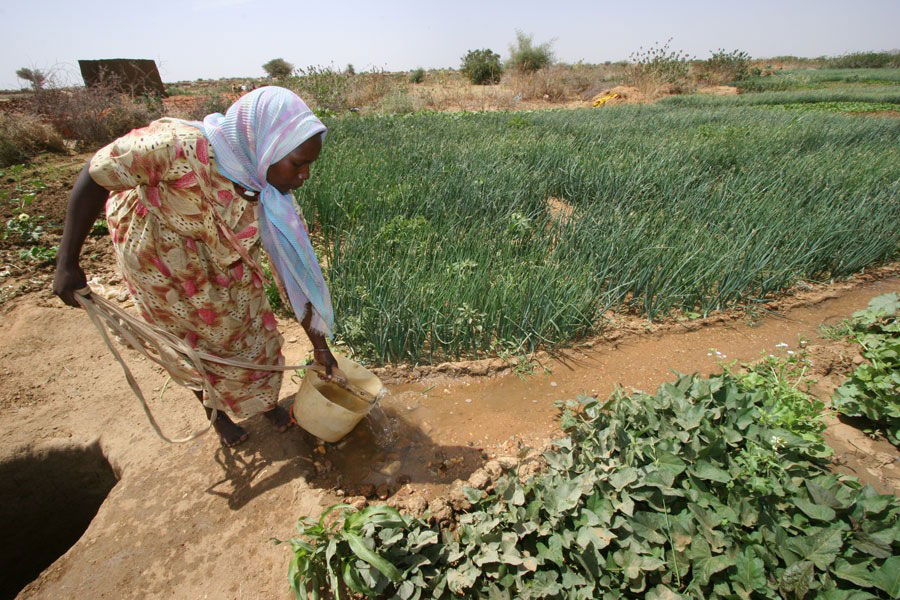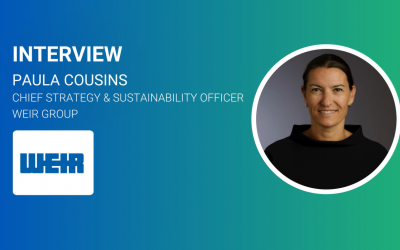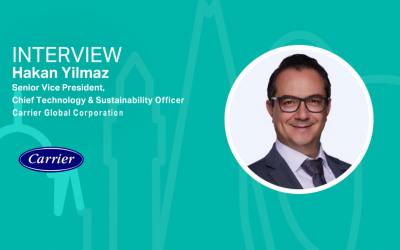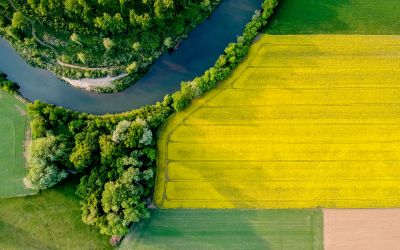Water: the key to climate change adaptation
We face inherent uncertainty when dealing with climate change phenomena, to which the water cycle is inextricably linked. By and large, all the impacts of climate variability are manifested through, by and with water.

The real question, however, is what can the water sector do to render itself and populations less vulnerable to the wide-ranging impacts of climate change across sectors and across continents.
Indeed, adaptive water management is the answer to climate vulnerability, especially as it pertains to food security. By 2025, 1.8 billion people are expected to be living in countries or regions with less than 500 m3 of renewable water per year per capita. Two-thirds of the world population could be living under conditions of “water stress” (500 to 1.000 m3 per year per capita).
The situation will be exacerbated as demographic growth places increased pressure on the quantity and the quality of local water resources.
Increasing water consumption
Already, 180,000 new mouths ask to be fed every day. If food production is increased to meet these demands without improvements in agricultural practices, then water consumption will increase proportionally. The additional amount needed could reach as much as 1 trillion cubic meters of water annually, or the equivalent of 20 Nile Rivers.
Climate change is projected to have a significant impact on agricultural production, which already accounts for 70 per cent of the world’s freshwater withdrawals and provides livelihoods for approximately one-quarter of the world’s population. Already, losses due to drought are estimated at US$109 billion annually. In Africa, Asia and Latin America, for instance, yields could decline by between 20 per cent and 40 per cent if no effective adaptation measures are taken, while global demand is expected to increase by 40 per cent by 2050. Even if climate change is expected to increase crop productivity in certain areas, the research community generally agrees that climate variability and the frequency of extreme weather events will increase.
More specifically, arid areas are more highly exposed to climate risks and, consequently, to low agricultural yields. Floods, droughts, shifting rainfall and river-flow patterns are already affecting crop yields and challenging existing farming practices. For instance, since groundwater proves difficult to regulate, intensive groundwater withdrawals are exceeding rates of natural replenishment in key cereal producing locations. Because of the dependence on groundwater, declining aquifer levels and continued abstraction present a growing risk to local and global food production. In Yemen, groundwater withdrawals exceed recharge by 400 per cent, threatening the well-being of the population.
The need to secure water is paramount to providing significant and stable growth. To secure our future, we must understand that water security and food security are indispensable to one another.
Stakeholder participation
In such cases, the scientific information on climate services is not necessarily fully available, nor incorporated into decision-making processes. The fragmentation of responsibilities for actions taken in various aspects of water management in most countries suffer from insufficient coordination among the concerned organizations and stakeholders. In addition, inadequate institutional arrangements impede stakeholder participation in planning and implementation of water management and adaptation strategies.
To minimise risks in the face of unpredictable climate patterns, “no regrets approaches” must therefore be implemented. Resilient approaches providing positive externalities for mankind and its environment must be encouraged and funded. These new growth models should be implemented to ensure global, equal and permanent access to foodstuffs for populations in arid areas. This implies a better understanding of how water can provide solutions at different scales, be they local, regional or global.
Irrigation management
 In 2012, during the 6th World Water Forum in Marseille, the Platform of Solutions proposed a broad range of solutions related to water management for food security in dry lands.
In 2012, during the 6th World Water Forum in Marseille, the Platform of Solutions proposed a broad range of solutions related to water management for food security in dry lands.
As a solution to derive more crop per drop locally, the Water Management and Irrigation Institute of the University of Gezira in Sudan shared an experience with farmer associations to implement a program to adapt crop choices and change irrigation intervals and cycles according to climate fluctuation.
The farmers in Kordofan and Darfur (pictured left) have shifted their crop sowing dates to cope with shorter wet season length and to link their crops to the winter season to strengthen productivity.
Another solution proposed in Morocco supplies information to farmers via the Internet and by SMS from 35 meteorological stations in the Souss Massa region, calculating precise irrigation needs on a daily basis in function of the climatic conditions for maximum efficiency. At full capacity, the project could save up to 66 million cubic meters of water per year and use approximately 22 per cent less energy.
Climate Change Risk Management Program
In other cases, we must overcome not so much a lack of water availability but a governance crisis or one of institutional capacity. These objectives require preparing climate scenario outputs for assessment of 
The countries surrounding the Nile (pictured right) have many different water use requirements ranging from hydropower to crop irrigation. Managing and developing water resources within the basin must not only address different water uses but also eventual conflicts between developments upstream and water use downstream among the different countries in the basin. In addition, the region is facing rising levels of water scarcity, high population growth, watershed degradation and loss of environmental services. Any future changes in the water quantity and quality and their distribution in space and time will have important impacts on water and food security for the entire region.
In this regard, water storage should be considered as a tool for “risk management” in order to provide resilient water supplies. Water availability must be increased with more storage capacities and associated efficient water resources management. The Annual GDP of some countries in Africa has a direct correlation with annual rainfall. Therefore, if we store more rain, that is to say, more water in reservoirs, then we will be able to solve this equation.
Water resources management
The semi-arid Brazilian NE, called the drought polygon, is an area that has 3 per cent of the country’s water for 30 per cent of the Brazilian population. In order to promote regional development, a system of multi-purpose reservoirs for hydropower, navigation and irrigation were developed in the 60’s in the Sao Francisco river basin. The largest reservoir in the system, Sobradinho has a storage capacity of 34 billion cubic meters. Significant increases in regional GDP were observed after the implementation of the infrastructure. But, the major improvement has been in the reduction of infant mortality. In the 30 years before the implementation of the system a reduction of 16 per cent was observed, while in the 30 years after the reduction was of 55 per cent.
Water availability must, therefore, be increased with more storage capacities and more efficient water resources management. Supplemental irrigation has major potential for increasing water productivity and income levels. But, let us not forget the other end of the food supply chain: An estimated 1.3 billion tons of food are wasted every year, at every step from production, to processing, to storage, to transport, to retailing, to the table. If we were to reduce this figure by half worldwide, we would save 1,350 cubic kilometers of water per year, or about ten times the volume of the Aswan Dam.
Building resilient societies
Adapting to climate change means understanding the role that water plays in the global economy, development, and the health and wellbeing of people everywhere. Adapting also means acting to ensure that measures are taken to make all sectors, including agriculture, more resilient and robust. Investment in national water resources management capacity, institutions and infrastructure must become today’s early response priority. Investing in water is sustainable development financing that will deliver substantial adaptation benefits and help build more resilient societies. An ounce of prevention is worth a pound of cure; thus, investing in water now will lead to averted exponential costs and great benefits in increased productivity in the future.
Water security provides a focus for adaptation strategies and a framework for action. Adaptation responses to climate change must, therefore, converge with the goal of water security for all - which, broadly defined, means harnessing water’s social and productive potential and limiting its destructive force. In this respect, the World Water Council has been advocating for global recognition of water security as a necessary component within the upcoming Sustainable Development Goals (SDG). Water must be considered throughout the SDG framework, but a dedicated water SDG is also necessary to further encourage progress and achieve water security throughout the world for future generations.
Efficiency must also be encouraged and wastage avoided, consuming less and managing better. Infrastructure decisions should be made within the context of broader water resource management, long-term sustainability, and building climate resilience. The return on investment in water is exponential, and widespread investments are needed now so as to promote development through water security in every domain.
Summary
Unpredictable climate patterns are putting water availability at risk. With nearly 40 per cent of humanity living in drylands, new solutions to secure water and food must be implemented to preserve our Earth’s ecosystems and people’s livelihoods and well-being. In 2012, during the 6th World Water Forum, the World Water Council collected many solutions to tackle issues encountered in arid areas. The issues are known. Investing in water resources development and management is now the only solution to secure our common future.








